Sushi comes in many varieties and it’s marketed as one of those healthy Japanese foods. Generally, sushi is healthy food but upon a closer look, there are many calorie-laden versions that add extra inches to your waistline and you don’t even realize that sushi can be fattening!
Authentic Japanese sushi, made with fresh raw fish, seaweed, and veggies is low in calories and can potentially be a very healthy meal option. While sushi rice contains a fair amount of carbohydrates, you can eat rice-free sushi (this is called sashimi).
Your typical 6-piece sushi roll contains between 200-250 calories. The sushi maki rolls with the lowest calorie count are those with fish and vegetables and no extra sauces, like the avocado roll. Sushi rolls with fried tempura batter, many fillings, and extra sauces like the rainbow roll have the highest calories count.
Even a standard sushi roll can be a healthy treat without breaking the calorie bank, as long as it doesn’t contain any fried ingredients.
In fact, most sushi is a low-fat, low-calorie food. The hidden calories are a big problem in many Western versions of sushi, like shrimp tempura rolls and rainbow rolls. These are jam-packed with fatty ingredients and lots of sauces that add to the total calorie count. Surely, the fried ingredients, extra mayo, and fatty fish are not the most diet-friendly ingredients. So, if you want to consume fewer calories, the best option is sashimi, or sushi with vegetables, brown rice, and healthy fish. Skip anything fried or loaded with sauce.
In this section, I discuss the calories in sushi and the nutritional values you are likely to find in the most popular sushi rolls.
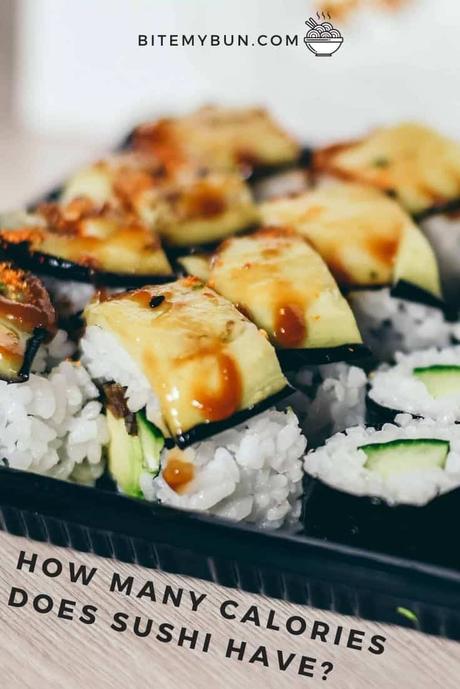
I’ve gathered data about nigiri sushi, maki sushi (rolls), sashimi, and the side dishes you may find in a Japanese restaurant, and even products frequently found in grocery stores such as Whole Foods.
Hopefully, this data will help you make informed choices if you’re watching your calorie intake.
Calorie counts for the most popular Sushi Rolls
Everyone can enjoy sushi. It’s almost an American pastime to go out to eat sushi. There are so many sushi rolls to choose from, that I never know which one to order!
Will I order the spicy tuna roll or the rainbow sushi roll? The California roll or the spider roll? This made me wonder which are the healthier sushi rolls and which ones have more calories?
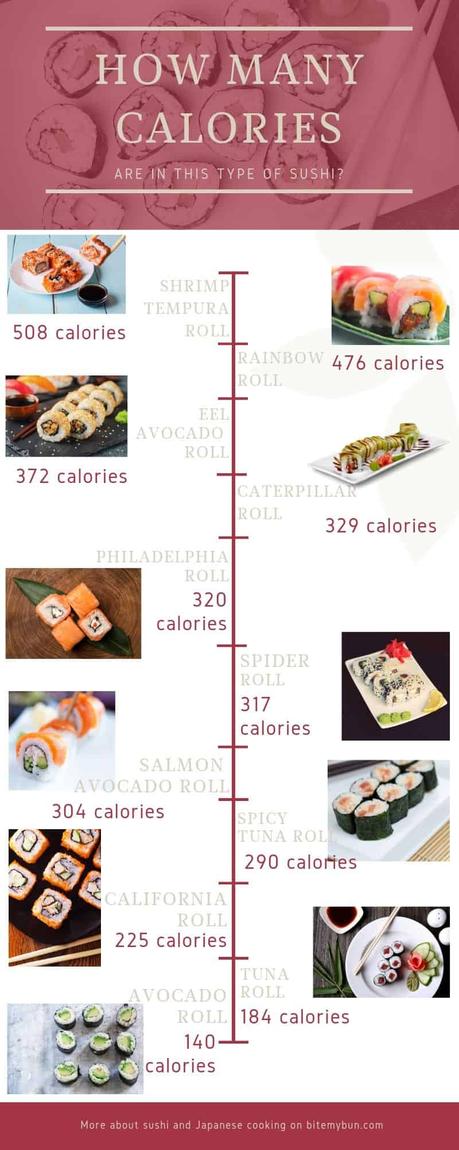
I’ve listed the most famous sushi rolls here (from the highest number of calories to the lowest) so you can become an expert in sushi too.
The reality hurts when it comes to high-calorie rolls, but sometimes a nice sushi roll is worth it. You just don’t expect small rolls to contain too many calories. But, depending on the ingredients, there is such a variety when it comes to the number of calories.
Did you expect the shrimp tempura roll (one of the most beloved sushi varieties) to be so unhealthy? That’s why you need to feel better about choosing the avocado roll, even if it seems like your missing out on those yummy flavors. You’re actually skipping many extra calories and consuming less unhealthy carbs and fats.
These calorie counts are for 6 piece sushi rolls, which you’ll mostly get when ordering them or getting takeout:
Sushi Roll
Calorie Count (per roll)
Percent of recommended daily calorie intake (female) based on 2000 calories/day
Diet: Weight Watchers Smart Points
Shrimp tempura roll
508
25.4%
19
Dragon roll
507
25.3%
19
Rainbow roll
476
23.7%
15
Eel avocado roll
372
18.6%
14
Caterpillar roll
329
16.45%
10
Philadelphia roll
320
16%
11
Spider roll
317
15.8%
12
Salmon avocado roll
304
15.2%
10
Spicy tuna roll
290
14.4%
9
California roll
225
11.25%
8
Tuna roll
184
9.2%
4
Avocado roll
140
7%
6
Salmon sashimi
25-40 per piece
2%
1
Tuna sashimi
31 per piece
1.5%
0
Sushi roll calories explained
Shrimp Tempura Roll (508 calories)
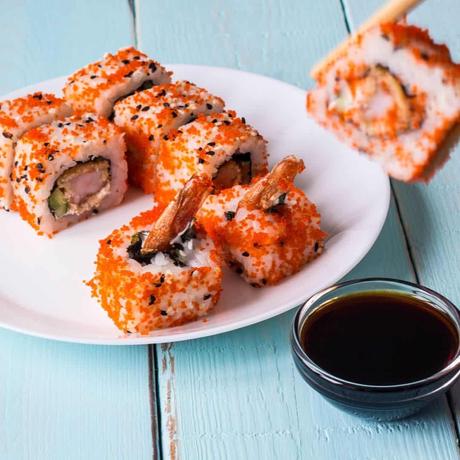
The Shrimp Tempura Roll has the most calories because the shrimp is breaded and fried, providing a crunchy, delicious taste to the shrimp. It contains 508 calories, 21 grams of fat, 64 carbohydrates, 20 grams of protein.
While this sushi has the most calories, the most adventurous sushi lovers will definitely order it. There’s no doubt it’s one of the tastiest sushi rolls.
Dragon Roll ( 507 calories)
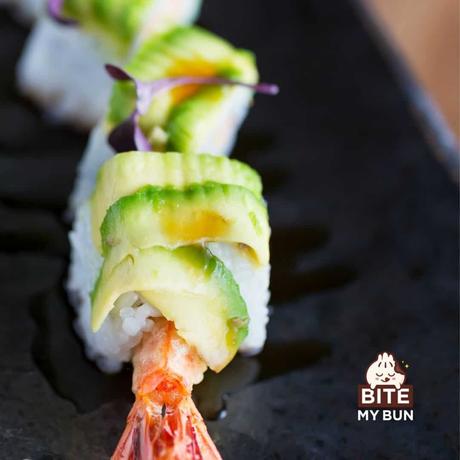
The dragon roll is packed with tasty ingredients, but it is fatty and high in calories. It contains 507 calories, 18 grams of fat, 10 grams of protein, and 66 grams of carbohydrates.
This roll contains delicious tempura shrimp, eel, cucumber, avocado, and tasty roe. But, it’s covered in a thick (and unhealthy) sauce.
Rainbow Roll (476 calories)
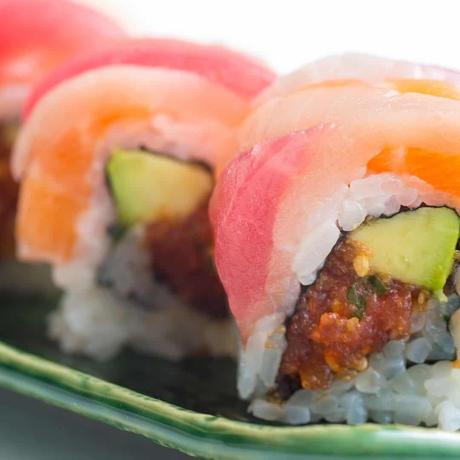
For those who want a bit of everything, the Rainbow Roll is the one they should be looking for. It contains 476 calories, 16 grams of fat, 50 grams of carbs, and 33 grams of protein.
This sushi roll is classified as one of the most varied and protein-packed rolls because of the different types of fish on top. And while it’s high in calories, it’s a colorful and flavorful meal.
Eel Avocado Roll (372 calories)
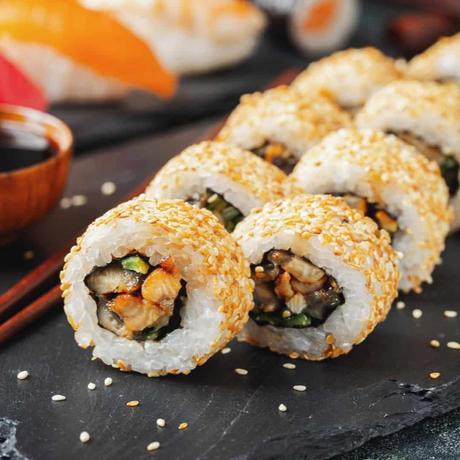
Eel is chewy and one of sushi’s most fatty fish. The Eel Avocado Roll contains 372 calories, 17 grams of fat, 31 grams of carbohydrates, 20 grams of protein.
This roll is packed with protein, and although that’s a good thing, it needs a sophisticated sushi palate because not everyone is “excited” by its taste.
Caterpillar Roll (329 calories)
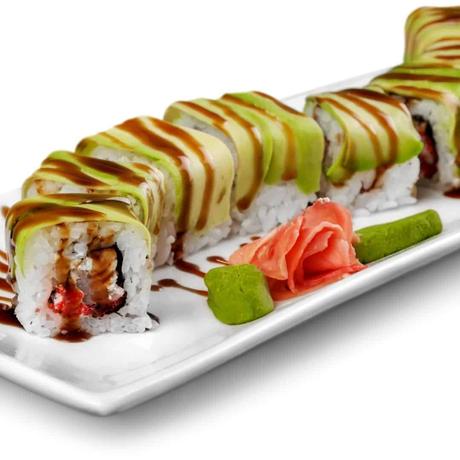
Caterpillar Roll got its name from the avocado slices it’s topped with. It has 329 calories, 5 grams of fat, 60 grams of carbohydrates, and 9 grams of protein.
This roll generally includes eel, tobiko (fish roe), and cucumber in addition to the avocado.
Philadelphia Roll (320 calories)
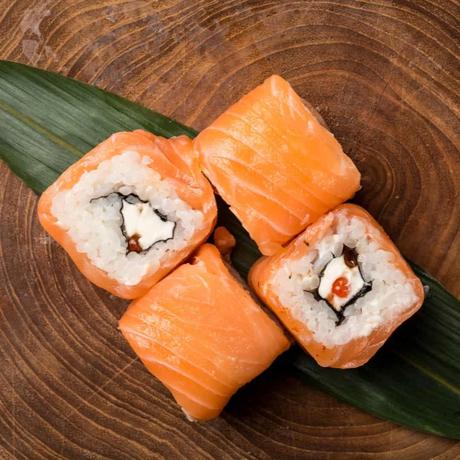
You will find salmon and cream cheese in the Philadelphia Roll, making it one of the more caloric sushi rolls. It has 320 calories, 8 grams of fat, 32 grams of carbohydrates, and 8 grams of protein.
If you like the taste of cream cheese with seafood, it’s a nice comfort roll to order and one of the best ones.
Spider Roll (317 calories)
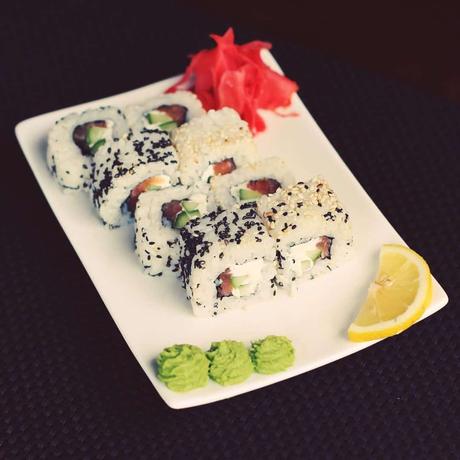
The Spider Roll consists mainly of battered crab, which adds flavor and calories to a roll that is otherwise pretty basic.
It has 317 calories, 12 grams of fat, 38 grams of carbohydrates, and a protein content of 13 grams. The crab’s fried preparation adds fat, but it’s still a very famous and delicious roll.
Salmon Avocado Roll (304 calories)
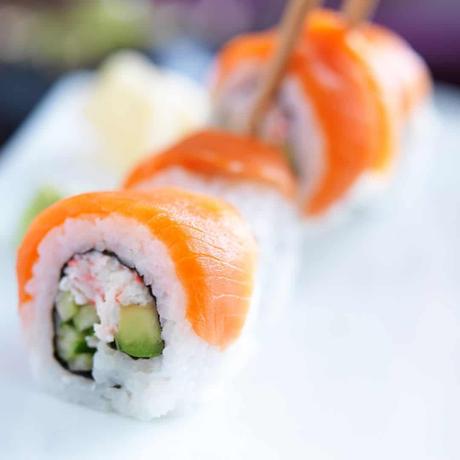
The Salmon Avocado Roll has “health advantages” written all over it. There are 304 calories in this sushi roll, 8.4 grams of fat, 42 grams of carbohydrates, and 13 grams of protein.
Since it’s full of omega 3s and good fats, it is fantastic.
Spicy Tuna Roll (290 calories)
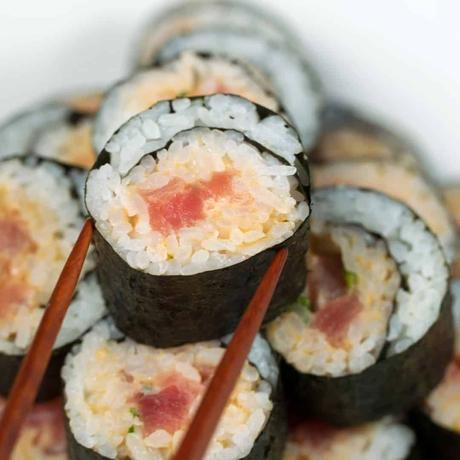
The Spicy Tuna Roll has more pizzazz and spice than the standard tuna roll. It contains 290 calories, 11 grams of fat, 26 grams of carbohydrates, 24 grams of protein.
The delicious “spiciness” comes from the use of mayonnaise (which contributes to the calorie count), hot sauce, and green onions.
California Roll (225 calories)
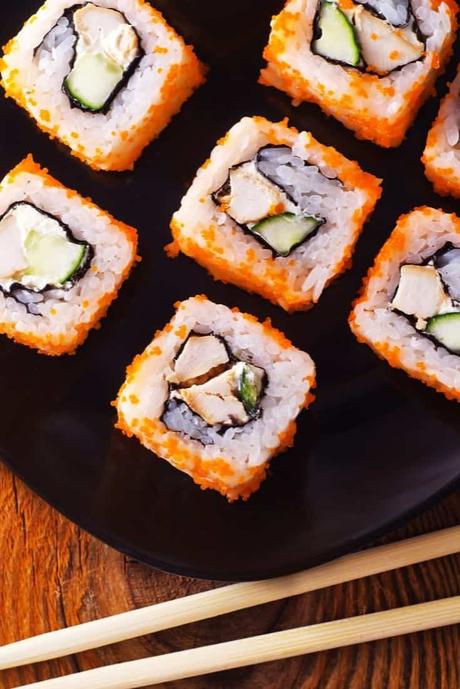
The California Roll is one of those classics everyone loves. It has 225 calories, 7 grams of fat, 28 grams of carbohydrates, and 9 grams of protein.
It’s the ideal roll for beginners to try making sushi for the first time, or for a light meal.
Tuna Roll (184 calories)
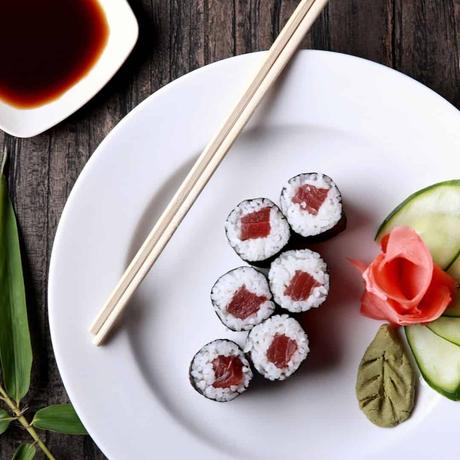
With the added protein, the Tuna Roll is still pretty simple. It has 184 calories, 2 g of fat, 27 g of carbohydrates, and 24 g of protein.
This roll is an excellent choice with light fish without the “spicy” tuna element.
Avocado Roll (140 calories)
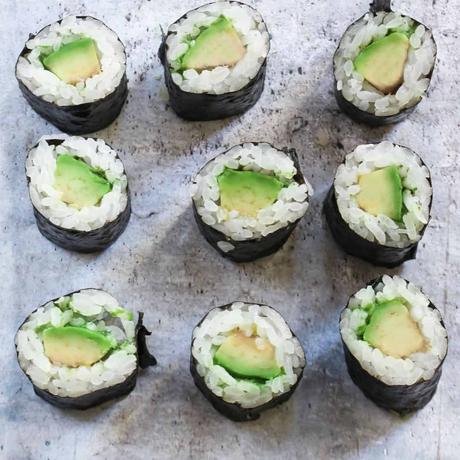
The Avocado Sushi Roll includes the smallest quantity of calories as it is one of the most basic ones to order.
There are 140 calories in an avocado roll, 5.7 grams of fat, 28 grams of carbohydrates, and 2.1 grams of protein. This roll is light and perfect for those who don’t enjoy fish. It’s also vegetarian and vegan friendly, so you can’t go wrong with it!
Also read: sushi, a beginners guide
Salmon Sashimi (25-40 calories)
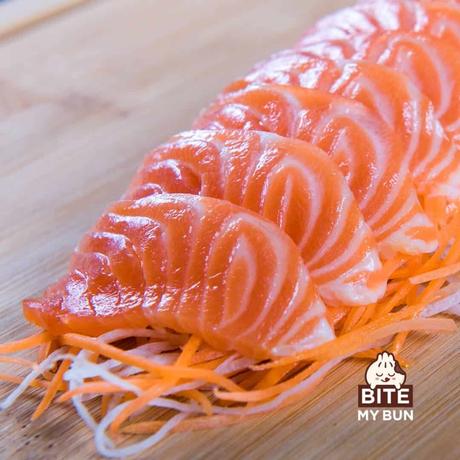
Salmon sashimi is healthy and the perfect low-calorie option. It has the lowest calorie count on this list but it’s not maki sushi so there is no rice.
One ounce of raw salmon has about 25-40 calories. I am not calculating the calories per roll, but rather calories per piece since it’s served in pieces.
So, a piece of sashimi usually contains about 40-50 calories, 20 grams of protein, and it’s a great source of Omega 3 fatty acids as well as all the B vitamins.
Tuna Sashimi (31 calories)
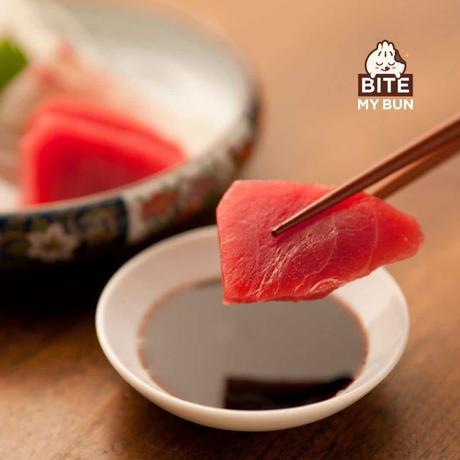
This rice-free raw tuna sashimi also has one of the lowest calorie counts on a sushi menu. It has about 31 calories per serving. I am again calculating the calories per piece.
Tuna is also a very low-fat fish, so the sashimi serving contains only 0.1 grams of fat and 11 mg of cholesterol.
Where do the calories come from?
Nori, rice, veggies, fish, it seems like this is all relatively healthy. So, where do the calories come from? Which ingredients are healthy and which are unhealthy?
White rice:
White rice is your number one enemy when it comes to calories in sushi. After all, the main component of sushi is rice. White rice is a problematic ingredient because it’s low in fiber, a source of refined carbs, and it’s stripped of most nutrients. Thus it’s just a source of refined carbs and no real health benefits. White rice is processed food and during the processing, the nutrients are stripped. When you consume too many refined carbs, your blood sugar rises and the body experiences inflammation.
Sushi rice is also low in fiber and combined with vinegar and sugar, it causes the body to break it down quickly. This leads to insulin spikes and is dangerous for diabetics.
If you choose brown rice sushi, it’s a much better option because it contains more fiber and fewer calories.
Tempura & sauces:
The fillings and toppings are a big source of calories. Many fillings are low in protein content but high in fat. So, when you choose sushi with high-fat sauces, you are adding calories.
Unfortunately, tempura batter is full of calories. If you’re eating fried shrimp rolls, the fatty batter cancels out any of the shrimp’s health benefits.
Takeaway: A lot of popular sushi rolls contain lots of rice, small amounts of seafood, and veggies, and instead are loaded with fatty sauces. Therefore, you consume lots of calories, little fiber, or protein, so you don’t feel full and overeat.
How to eat sushi when losing weight
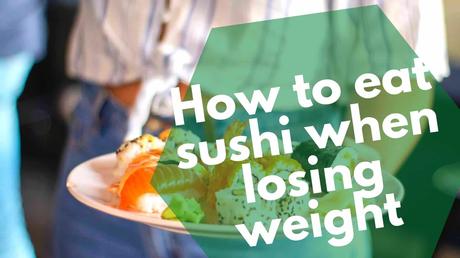
Sushi is a pretty good option for dieters, but as I keep mentioning, it does contain some ingredients that can be a bit fattening.
Sushi mainly consists of three ingredients:
- Nori seaweed
- Seasoned white sticky rice
- Fillings
Choosing a healthy sushi filling
Now, the filling can be anything you choose so as long as you choose a healthy option your pretty much good to go. You can always just choose cucumber and maybe a few slices of carrot and it would still taste great.
But fish with lots of omega 3s might be a great option too.
Best low-calorie sushi fillings
- cucumber
- avocado
- pickled vegetables
- mackerel (fish)
- salmon (but skip the sauce)
- radish
- boiled shrimp (not fried in tempura batter)
- raw crab & imitation crab
- tuna
- sea vegetables
- carrots
- seabass (fish)
- whitefish
Health Benefits of Seaweed in sushi
Nori or seaweed is high in fiber and protein. As well, it contains vitamin B12, which is hard to find in other foods and helps make DNA and keeps cells healthy. If you’re anemic, you’ll be glad to know seaweed is a good source of iron.
But that’s not all! Nori is also a source of minerals, including zinc, tyrosine, and iodine which promote healthy thyroid function. Now, your thyroid balances out your hormones and that is essential because dramatic changes in hormone concentrations can also lead to weight gain.
Seaweed helps maintain the equilibrium and includes a lot of fiber without calories as an added bonus!
I was really enthusiastic when I discovered this and the calorie-less fiber enables you to feel more full for longer periods of time, and it also delays those irritating hunger yearnings.
Tell me that doesn’t sound amazing.
Here is Dr. Eric Berg explaining the benefits of roasted seaweed:
Sushi vinegar contains sugar
Rice vinegar is exceptional and perfect for digestion, but it also helps the body absorb nutrients from other foods you consume.
It is a great inducer of weight loss and it balances some of the peskier ingredients in sushi such as soy sauce that is high in sodium.
Now, the soy sauce is really salty and you might want to skip it if you’re trying to watch the amount of salt you eat since there are other low-sodium options available. You can usually find low-sodium soy sauce (https://www.amazon.com/Kikkoman-Less-Sodium-Sauce-15-0/dp/B0721MBNLZ/ref=sr_1_10?crid=TQKIMPGYEQX8&dchild=1&keywords=low+sodium+soy+sauce&qid=1614774604&sprefix=low+sodium+%2Caps%2C280&sr=8-10)
Sushi rice is normally seasoned with sushi vinegar which also contains sugar but you can just only use the rice vinegar instead.
With so many health and weight loss advantages, these three components in sushi are fairly much jumping out.
Since we have identified advantages for some of the most commonly used ingredients, we still need to tackle the white rice problem.
White rice is a no-go if you want to lose weight but sushi can’t be sushi without rice and I have to say it’s bull as much as I agree with it.
There are plenty of excellent sushi rice options that leave sushi in its purest, most holy form to be sushi.
Or, you can just choose nigiri sushi and sashimi with less rice.
I’ve also got these five sushi without rice recipes you can make at home, or read on for more healthy rice tips.
Healthy substitutes for white rice
White rice can be replaced with high fiber cauliflower rice that makes it great for digestive reasons and makes you feel full faster to reduce your calorie consumption.
What’s fantastic, too, is that a lot of locations are starting to serve sushi rolls made with cauliflower rice. Restaurants and takeout places are realizing that consumers are increasingly interested in vegan sushi as well as low-calorie and healthy sushi.
Quinoa can also be a substitute for rice, it is high in fiber and also gluten-free! In restaurants serving sushi, it’s an up-and-coming star.
You can also make sushi with brown rice which helps, but you still need to watch how many pieces you eat. And I haven’t seen that many restaurants that serve it, which is a shame since brown rice is healthier.
Last but not least, arborio rice, which is effectively risotto rice, is a secret of home cooking. But, I’m not sure it’s really that tasty in sushi.
Arborio rice has antioxidants that assist in increasing metabolism, which can greatly help in the weight loss process.
With everything you do or eat, too much is not useful for you, and you still need to be aware of how much you eat, even with all the added bonuses of weight loss by eating sushi.
Sushi is a seductive tempter and you can eat up to twenty sushi pieces or more before you even realize it. I must emphasize that even though it’s nice, you must attempt to keep it at 12 pieces max. A sushi roll has 6 pieces so you can choose two types of rolls and it will keep you full!
Whether you’re male or female, it doesn’t matter how much you’ve eaten because, yes, eating food that’s great for weight loss but overdoing it by eating too much would just negate the impact.
If you’re worried about rice, you can also eat sashimi which is just the freshly cut fish instead of on rice
How to Order Sushi When Trying to Lose Weight
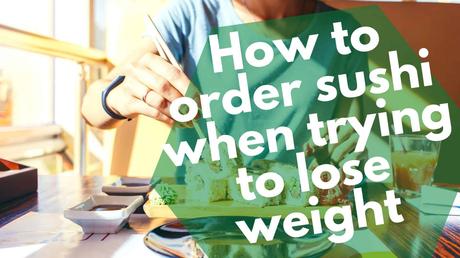
I am a huge sushi fan. I’m somewhere between those who only eat cooked fish and those who gladly consume a whole plate of raw and unidentifiable seafood, regardless of what it might be. What I appreciate in my sushi is variety.
Japanese cooking, and sushi, in particular, tend to have a good reputation as healthy foods. Most people regard it as low-calorie and safe regardless of what you order. When you order though, you still have to be careful to avoid the tempting ones.
Sushi restaurants offer lots of reduced and higher-calorie products on their menus. The secret is to know how to order sushi when attempting to lose weight.
When you get the menu, you’ll notice these terms:
nigiri (which is a tiny piece of fish on top of a finger-shaped rice cake)
maki (which is rice and fillings, fish, veggies, etc. rolled up in nori or seaweed)
sashimi (plain raw fish)
Check the description of ingredients and begin by looking at the raw fish, salmon, crab, whitefish options, and the vegetarian or vegan rolls.
Look out! If you want to avoid calorie bombs, there are several words to look out for when ordering sushi.
Here’s what to do:
Avoid anything with tempura & crunchy textures
- Tempura–means fried. Tempura shrimp or spider rolls each have more than 500 calories.
- Crunchy implies fried batter parts. Anything that is “crunchy” will substantially increase the roll’s fat and calorie content without any advantage for your health.
Avoid sauces & extras & anything spicy
Spicy–contains mayo. The beloved spicy tuna roll can comprise an additional 100 calories merely from the spicy mayo over a standard tuna maki roll.
A California Roll made of imitation crab, cucumber, avocado, and rice rolled in seaweed seems to be the most common menu item for sushi newbies. It’s a good option as it’s somewhere in the middle between low and high-calorie count.
Depending on who produces it, calories can differ extensively but it appears to average around 250-300 calories per 6-piece roll. Pay special attention to California Roll Combos offering 3 California Rolls, soup, and salad.
That complete meal can contain more than 1000 calories!
Those with veggies or fish without extra sauces or mayo such as tuna or cucumber rolls containing less than 200 calories for 6 parts are the smallest calorie maki rolls.
Clocking in at about 300 calories per roll, are rolls such as salmon avocado, or spicy tuna. These are rolls that are “traditional”. Usually, traditional and authentic Japanese sushi is simple and contains far fewer calories than the Americanized versions. These are often unique, like the Philadelphia cheese and salmon roll but that one has more calories because of the cream cheese.
As well, unique and Westernized sushi pieces are much larger and their calorie count is much greater.
Also read: have you tasted the sushi eel yet? Some say it tastes like raw salmon, others catfish. Find out more
The ultimate secret to saving calories is to order a rice-free Naruto Maki Roll that is fish and veggies rolling in thinly sliced cucumber.
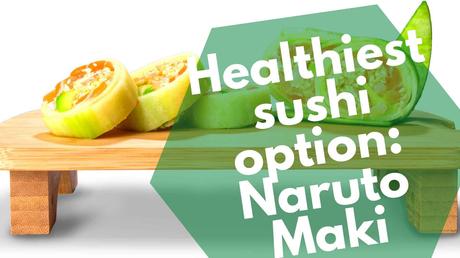
For those who are really attempting to stretch out their meals, this is a high protein, low carb option. A tuna, salmon, and avocado Naruto maki contains about 110 calories and 13 g of protein.
Depending on the sort of fish, Nigiri sushi averages about 40-65 calories per single piece. This is a good, healthy, and low-calorie option.
Whitefish, sea bass and crab tend to the lesser end of the spectrum. The higher calorie fillings include fatty fish such as eel, mackerel, and salmon. But, salmon is not the problem, it’s the other ingredients that are combined with it.
From a calorie point of view, Sashimi is the winner, with every ounce of raw fish having between 25-40 calories somewhere. Ideally, with some of my authorized side dishes, you can skip the rice and complete your dinner:
- A salad (make sure to ask for any dressings on the side). Don’t use too much dressing, just dip your chopsticks in it, and you will save a lot of calories.
- Edamame: ½ cup= 100 calories, 3g fat, 9g carbs, 5g fiber, 8g protein
- Seaweed salad is surprisingly low in calories. The average restaurant serving contains anywhere from 45-70 calories depending on the source. Plus, seaweed is healthy and filling.
- Miso soup: 1 cup = 40-50 calories, 1.3g fat, 5.3g carbs, 1.1g fiber, 3-4g protein
General tips to order healthier versions:
If you choose rice products, ask for brown rice. Although the caloric content is basically the same, some additional nutrition and filling fiber will benefit you.
Despite adding additional calories, products such as salmon and avocado provide heart-healthy fat. Don’t be afraid of salmon sushi, but avoid the cream cheese and spicy mayo.
Now for the best tip out of the list: ask for your maki rolls to be cut into 8 pieces instead of 6 pieces, whenever possible.
Do you ever feel like every piece of a sushi roll is too large to fit comfortably into your mouth? And there’s no way either to bite it gently in half, right? This solution will, therefore, function perfectly.
I always ask the restaurant to cut my rolls into 8 pieces (some rolls that aren’t typically cut into 6 won’t cut readily into 8 like bigger unique rolls).
You’ll get a perfectly shaped bite and now it looks like you’ve got more food for the same calorie quantity. Win-Win!
Note: those who very often consume sushi, especially the ahi tuna, need to be aware of the mercury content, especially women of childbearing age and children (who shouldn’t eat raw tuna anyway).
Also check out these amazing Japanese steamed bun recipes
How does sushi compare to other takeouts?
When you choose sushi as your takeout of choice, you may be consuming fewer calories, but you can easily exceed 1000 calories per meal depending on how much you eat.
Sure, compared to a fast-food-type beef burger with tons of mayo and tasty fillings and a side of french fries plus soda, sushi seems healthy.
It’s healthier and lower in calories than common Chinese takeout foods. Also healthier than most microwave meals. But, is it the healthiest takeout food, as many would have you believe?
There are some really healthy takeaway foods, including vegetable soup, tom-yum soup, meat-free salads, stir-fried meats, grilled meats, fish dishes, veggie dishes, and steamed meats with vegetable sides.
Sushi is definitely on the healthier side of the takeout spectrum. It’s usually lower in fat and calories than common takeout meals like pizza, sandwiches, subs, Chinese meaty dishes, burgers, chicken strips & wings, curries, etc.
If you have to choose between the foods listed above, choose the sushi. But, be conscious about sauces, skip the soy sauce, and choose raw fish or veggies instead of other meats and fried fillings.
